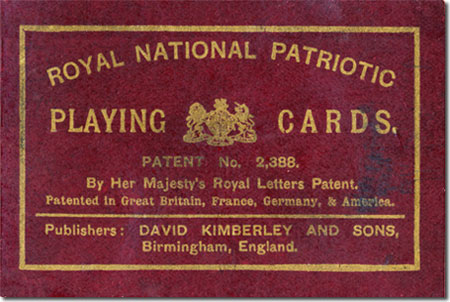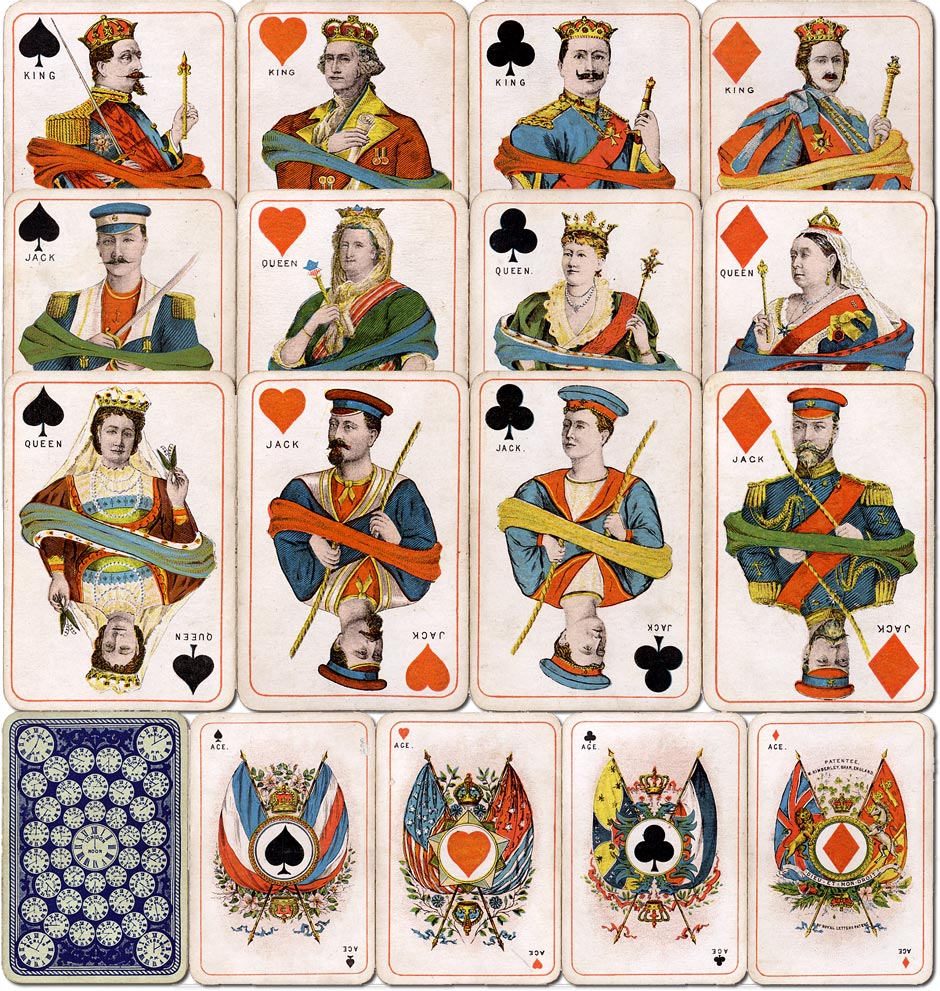Kimberley
Kimberley’s Royal National Patriotic playing cards, c.1892-1905.

Above: detail from one of the two-part sliding boxes. David Kimberley & Sons, who published the cards, were not previously printers or publishers but manufacturers of carpenters' saws and planes in Birmingham at that time.
Kimberley’s Royal National Patriotic playing cards, c.1892-1905.
“They differ from ordinary cards in having combined with each suit a special distinct nationality of style and appearance. Instead of the ordinary Ace card, I make an Ace which exhibits an illustration of the representative flag of that suit's nationality. Instead of the normal King, Queen and Knave I propose to place a good portrait of the rulers or representatives of the countries indicated...”
Kimberley’s “National Patriotic” playing cards represent four nations: Diamonds represent England, Hearts represent America, Spades represent France and Clubs represent Germany. The Ace card of each suit represents the ‘Royal Standard’ or flag of each Nation. For England (Diamonds) the Union Jack; for America (Hearts) the Stars and Stripes; for France (Spades) the National Colours and for Germany (Clubs) their Royal Standard. Courts represent contemporary and past royalty. The backs usually show an array of clocks in various colours.
The First Edition c.1892-93

Above: Kimberley's Royal National Patriotic playing cards, first edition c.1892-3. The court cards are richly coloured and incorporate gold see more →
The numerals follow a scheme proposed by Kimberley in his patent application of 1892: a large suit-sign occupies the centre of the card, with the numeric value voided in it twice. The pack has non-standard aces, non-standard courts, non-standard colours for pips (spades are blue, hearts maroon) and the pips on the numeral cards occupy almost the entire card.

Above: numeral cards from Kimberley's Royal National Patriotic playing cards, first edition c.1892-3. This is the only version with giant suit marks on cards 2 to 10; subsequent editions had conventional suit marks see more →
The cards bear no advertising, nor is there any indication that the cards were intended for commemorative purposes. The fact that they ran into at least five distinct editions suggests they were popular during their ten or twelve years of production, i.e. c.1892-c.1905.
The Second Edition c.1893-97
The court cards and Aces are the same in the first and second editions. Only the numeral cards differ.

Above: numeral cards from Kimberley's Royal National Patriotic playing cards, second edition c.1893-97. The numeral cards have conventional suit sign sizes and arrangement.
• Bibliothèque nationale de France: Jeu de cartes anglais "patriotique, royal et national"►
The Fourth Edition c.1899-1901

Above: Kimberley's Royal National Patriotic playing cards from the fourth edition published c.1899-1901. The Jack of Hearts is a typical representative from the U.S. Navy of the time. The King of Clubs shows Kaiser Wilhelm II. Unlike the first edition which was printed in luxurious colour lithography including gold, the designs here are rendered by means of fine outlines, stipple printed in black, with areas of mainly flat colour. The back design in this edition features a clock design ~ click image to zoom ~ and the set has an additional red descriptive card.
The Fifth Edition c.1902-05

Above: Kimberley's Royal National Patriotic playing cards from the fifth edition published during c.1902-5 with conventional corner indices. This edition also contained a Joker depicting a lady holding a card. The differences between the different editions in quality and method of printing suggest different printers were involved. See more →
NOTE: there is really not a great deal of difference between 'editions' and 'types', and certainly no strictly defined difference. Obviously every time there is a change in the design of the cards, it is a new edition, except maybe for the backs. One edition may be released with several different coloured backs. There might be minor differences in design, but if they are similar I think they could be considered the same type. Large differences could certainly be considered as a new type. There must be at least 20 different versions. For major changes though there would be just 5. The first edition with the very large numeral cards lasted only months before being withdrawn. There are only 2 packs known to exist today. The second edition courts were unchanged from the first edition. Only the numeral cards, A to 10, were radically changed. The third edition Aces show the 'cloud background', and the courts, whilst the same basic design, have a white background and are more crudely drawn. This could certainly be considered Type "B". The fourth edition Aces have totally new flags and court figures. The fifth edition introduces A K Q J etc to all cards, and the court colours are changed. There are also other fifth versions with the courts having differing width centre bands and colours. There are also numerous different coloured clock faces card backs for all but the first version, as well as a fair number of totally different backs as well. I am fortunate to have 13 of these packs !
REFERENCES
Denning, Trevor, "Kimberley's Royal National Patriotic Playing Cards" in the Newsletter, EPCS May 1984, pp.6-7.
All images on this page from the collection of Barney Townshend.

By Barney Townshend
Member since October 06, 2015
Retired Airline Pilot, interested in: Transformation Playing Cards, Karl Gerich and Elaine Lewis. Secretary of the EPCS. Treasurer of the IPCS.
Related Articles

Ben 10 playing cards
Characters from the American animated television science fantasy series Ben 10.

Doctor Who Trump Card Game
Game for two players in which Doctor Who and the Legendary Legion join battle with the Alien Hordes....

Disney’s Aladdin playing cards
Characters from the 1992 Disney film Aladdin.

2011 Worshipful Company Pack
Celebrating the bicentenary of the birth of Charles Dickens, with characters adapted from drawings b...

Jockey Club de Buenos Aires
Spanish-suited pack by Chas Goodall & Son Ltd for the Jockey Club, Buenos Aires.

New interest in old games
Games once fashionable are now eclipsed by quicker gratifications.

Polygo™
Cards of irregular, four-sided shape for playing word and colour games as well as more traditional o...

Treasures from the Bodleian Library
Rare books, manuscripts, music scores, portraits, maps, gospels, chronicles and other valuable artef...

Victorian grocer’s scale plate
Large flat plate decorated with highly coloured English cards and royal arms.

Queen of Arts
A wide variety of women artists celebrated on cards with illustrations by Laura Callaghan.

The Glasgow Pack
Issued to celebrate Glasgow’s reign as European City of Culture in 1990, with city views and works o...

Cathedrals, Abbeys & Minsters playing cards
54 pictures of different famous cathedrals, abbeys and minsters in England and Wales.

Christmas Carols
Christmas Carols playing cards illustrated by Stuart Dilks

Pam is the Knave of Clubs
Playing cards as metaphors in 18th century art - from fate, chance and social hierarchy t...

Question and Answer Games
A card game called “Impertinent Questions and Pertinent Answers” was launched in the early 1920s by ...

Dr Sacheverell
Dr. Henry Sacheverell's impeachment in 1710 sparked widespread public unrest and political upheaval,...
Most Popular
Our top articles from the past 28 days

